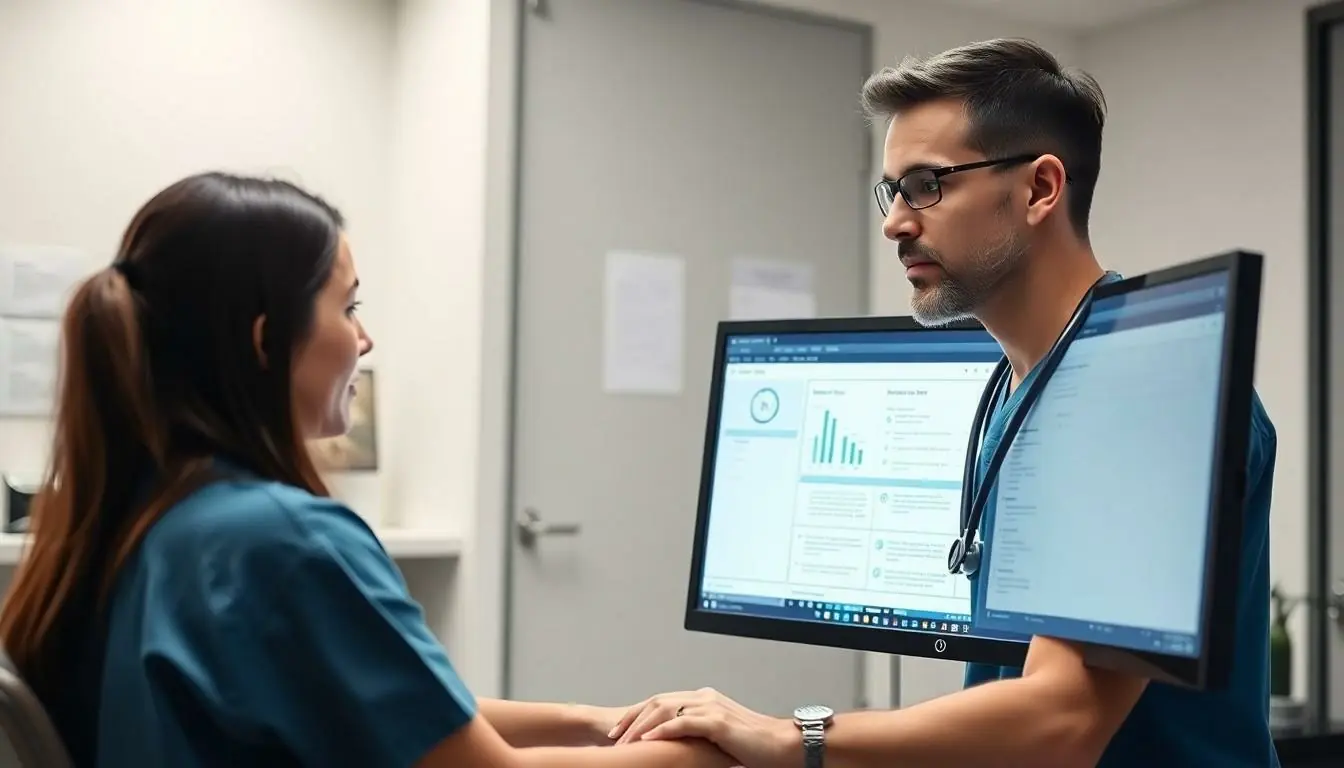Table of Contents
ToggleIn the fast-paced world of healthcare, Electronic Health Record (EHR) software development is the unsung hero keeping everything in check. Imagine a superhero with a cape made of data, swooping in to save the day by streamlining patient records and enhancing communication between providers. It’s not just about saving trees; it’s about saving time, money, and sanity.
With healthcare professionals juggling more tasks than a circus performer, the demand for efficient EHR solutions has never been higher. These systems not only help in managing patient information but also ensure compliance with regulations—because nobody wants to be the star of a compliance horror story. Dive into the world of EHR software development and discover how this technology is transforming healthcare, one byte at a time.
Overview of EHR Software Development
EHR software development focuses on creating systems that facilitate patient record management and improve communication among healthcare providers. This technology transforms how medical professionals interact with patient data. Many healthcare organizations prioritize efficient EHR solutions to help streamline workflows.
Designing EHR systems involves addressing user needs through intuitive interfaces and comprehensive features. Customization options enable healthcare professionals to tailor the software to specific practice requirements. Robust security measures play a critical role in protecting sensitive patient information, ensuring compliance with regulations like HIPAA.
Integration with existing healthcare systems enhances functionality and user experience. Seamless interoperability allows EHR software to communicate with laboratory systems, pharmacies, and other health technologies. Data exchange minimizes redundancies and promotes better patient outcomes.
Patient engagement features represent another key aspect of EHR software development. Portals that grant patients access to their records empower them to take charge of their health. Reminders for appointments and medication help reduce no-shows and foster adherence to treatment plans.
Cost-effectiveness contributes to the decision-making process of healthcare organizations. Investing in EHR software saves time and resources in the long run. Comprehensive training programs ensure staff can utilize the system effectively, maximizing the return on investment.
Research continues to highlight the importance of adopting EHR systems. Studies show that organizations utilizing robust EHR solutions experience higher levels of patient satisfaction and improved care coordination. Thus, EHR software development stands as a vital component in the evolution of the healthcare industry.
Key Features of EHR Software

EHR software includes several essential features that enhance its functionality and usability in healthcare settings. These features significantly contribute to the effectiveness of patient record management and overall workflow improvements.
User Interface and Experience
An intuitive user interface is crucial for EHR software. Users interact more efficiently with systems designed for ease of navigation. Simplified layouts allow healthcare professionals to access information quickly. Customizable dashboards present relevant data at a glance, improving task management. Streamlined workflows reduce the time spent on administrative duties. Overall, a positive user experience leads to increased adoption rates among healthcare providers.
Data Security and Compliance
Data security remains a top priority in EHR software development. Robust security measures guard against unauthorized access and protect sensitive patient information. Encryption protocols safeguard data during transmission and storage. Compliance with regulations such as HIPAA is essential for maintaining trust and avoiding legal issues. Regular software updates address emerging security threats and vulnerabilities. Comprehensive training programs ensure staff understands security best practices, promoting a culture of data protection in organizations.
EHR Software Development Process
The EHR software development process involves several critical stages that ensure the final product meets healthcare needs effectively.
Requirements Gathering
Understanding user needs stands as the first step in EHR software development. Stakeholders, including healthcare providers and administrators, participate in discussions to identify necessary features. This collaboration ensures that solutions address real-world challenges, such as patient data management and regulatory compliance. User stories and case scenarios often help clarify functional expectations. Documenting requirements meticulously leads to a shared vision for the project, ultimately guiding the design and development phases.
Design and Prototyping
Creating an intuitive design is vital for a successful EHR system. Designers focus on user experience, employing prototypes to illustrate interface concepts before full-scale development. Interactive mockups allow stakeholders to visualize how users will interact with the system. Feedback gathered during this phase results in iterative enhancements, ensuring that the final product aligns with user workflows. Customization options also play a pivotal role, catering to the unique needs of various healthcare settings.
Development and Testing
The actual coding phase brings the EHR software to life. Developers utilize programming languages and frameworks suited for healthcare applications, ensuring robust functionality. Simultaneously, rigorous testing occurs, involving unit tests, integration tests, and user acceptance tests. These evaluations verify that the software performs consistently and meets quality standards. Identifying and rectifying issues early minimizes risks and enhances system reliability. A comprehensive testing approach fosters confidence among stakeholders, culminating in a strong and dependable EHR system.
Challenges in EHR Software Development
EHR software development faces multiple challenges that affect its effectiveness. Healthcare organizations rely on efficient integration to function smoothly within their workflows.
Integration with Existing Systems
Integration with existing healthcare systems constitutes a significant challenge in EHR software development. Many healthcare providers utilize various technologies, making seamless communication crucial. When software fails to integrate smoothly, it creates data silos that hinder workflow efficiency. For instance, interconnecting EHR systems with laboratory, pharmacy, and billing software minimizes redundancy and enhances collaboration. Ensuring compatibility among disparate systems requires careful planning and technical expertise. As outdated systems often pose barriers, developers prioritize flexible architectures that support interoperability, facilitating smoother transitions to modern solutions.
Customization and Scalability
Customization and scalability present additional hurdles in EHR software development. Healthcare organizations vary in size and specialization, leading to diverse user needs. Developers must design solutions that accommodate these unique requirements without compromising functionality. Choosing components that allow for customization enables users to tailor interfaces and workflows to their specific environments. Scalability becomes essential as organizations grow or evolve, requiring systems that adapt easily to increased user volumes or additional features. Balancing customization with simplicity often presents a challenge, but achieving this balance enhances user adoption and overall effectiveness of the EHR system.
Future Trends in EHR Software Development
Artificial intelligence (AI) continues to shape the future of EHR software development. AI algorithms can analyze patient data, enabling predictive analytics that help healthcare providers identify potential health risks before they escalate. These advancements lead to more proactive patient care.
Interoperability remains a pressing need. Creating EHR systems that easily communicate with various health technologies enhances data exchange. Effective integration fosters seamless collaboration across healthcare teams and minimizes information silos.
Cloud computing is gaining traction. Utilizing cloud-based solutions improves accessibility for healthcare providers, allowing them to access patient data from anywhere with an internet connection. This flexibility promotes efficient decision-making.
Patient engagement tools are evolving. Customized patient portals enhance interaction, providing users with easy access to their health information. Interactive features support better adherence to treatment plans and enable shared decision-making.
Data security innovations are paramount. As cyber threats increase, developers focus on more sophisticated encryption and authentication methods to protect sensitive patient information. Maintaining compliance with regulations like HIPAA becomes even more critical.
Blockchain technology is emerging. Using blockchain for patient record management ensures secure, immutable transaction histories. This technology promotes trust in data integrity, enhancing overall patient safety.
Telehealth integration is expanding. EHR systems that incorporate telehealth features allow providers to manage virtual visits seamlessly. This approach leads to improved access to care, especially for patients in rural or underserved areas.
These trends reflect the ongoing evolution of EHR software development. Adapting to technology advancements results in more efficient, secure, and user-friendly systems that ultimately enhance patient care.
EHR software development stands at the forefront of healthcare innovation. By streamlining patient record management and enhancing communication among providers, it addresses the growing demands of the industry. The focus on user-friendly interfaces and robust security measures ensures that these systems not only improve efficiency but also safeguard sensitive data.
As healthcare continues to evolve, the integration of advanced technologies like AI and cloud computing will further transform EHR solutions. This ongoing development promises to enhance patient engagement and care coordination while maintaining compliance with regulations. Investing in EHR software is not just a trend; it’s a necessary step toward a more efficient and patient-centered healthcare system.






